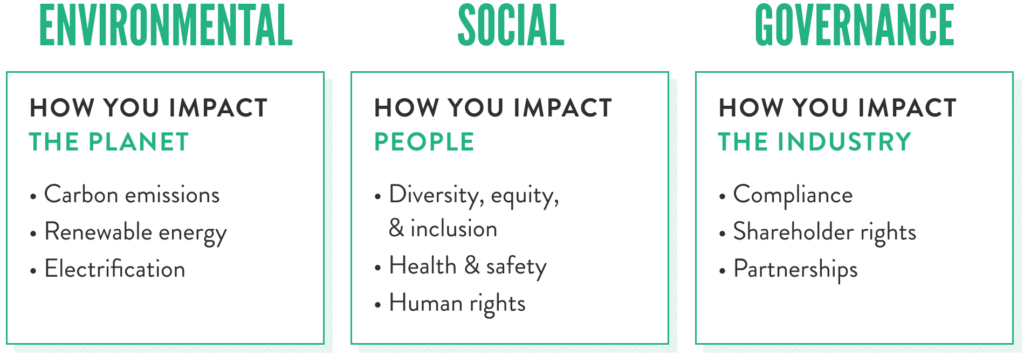Consumers, employees, and investors alike have high expectations for businesses when it comes to Environmental, Social, and Governance strategies. The concept of ESG has quickly evolved from a new way to evaluate a potential investment to a make-or-break part of business strategies.
What were once “feel good” stories now demonstrate how future-proof a company is, how well positioned it is amid emerging climate policy and regulation, and how it’s planning to attract and retain diverse talent to stay competitive.

Successfully communicating about ESG doesn’t just mean having one page on your company’s website dedicated to your goals or an annual report detailing your diversity initiatives and sustainability ratings; it’s also about the progress you’re continuing to make day by day.
At INK, we view ESG as a lens for all communications strategies. Meaning all of your integrated program channels — content, social media, and earned media — will help tell your ESG story. Ultimately, to achieve authentic ESG communications, your ESG strategy should become a part of your brand strategy.
Consider the following when building out your ESG communications strategy across all channels:
Media Relations
Find the ESG angle in every pitch and campaign
ESG is a mainstream conversation in publications, from national business to trade media. When strategizing around an upcoming press release or crafting a pitch, consider all the ESG angles to that story and anticipate any related questions reporters might have for you. Even a pitch that doesn’t strike you as an ESG topic, like announcing a new office opening, often still has an ESG perspective you can leverage, like the building’s decarbonization strategy or investment and job creation in the local community.
Content
Break down your ESG reports across content pieces
It’s common practice for companies to release yearly or quarterly ESG reports. For investors and government agencies, these reports are a sweet treat to dig into. For everyone else, your sustainability or diversity and inclusion report may come off as a long-form or dense material to scroll straight past. Think about how you can break these reports into multiple pieces of content across your channels and tell stories with their own context and human-interest angles.
For example, along with your sustainability report, create a Q&A blog series highlighting your company’s environmental initiatives through the eyes of employees who lead the charge. Interview with the intent to get meaningful, personal details that uncover how your programs positively impact people and the planet. Then, as you release your report, share these assets on your website, social media, and in a newsletter to tie it to a more compelling human-focused sustainability story.
Social Media
Spark conversation with commentary on social
LinkedIn, X, Facebook and Instagram are all platforms where conversation, progress, and creativity meet, making them the perfect place to implement an ESG communications strategy. Your company can take on a more conversational tone on social media with content that makes people think and invites them in for a discussion.
Say you’re a tech company sharing a new study on growth and innovation in your field with a compelling visual. In your commentary, you could tie the study to your initiative that’s building the next generation of female developers and closing gender gaps in the tech industry. Ask your audience to shout out an inspirational woman in STEM in their life. This approach promotes your study and starts a conversation that opens your company up to transparent interactions with key audiences, helping to gain their attention and trust.
Thought Leadership
Turn spokespeople into your ESG champions
You might have heard the saying: “Your CMO and CEO should double as the CSO (Chief Sustainability Officer).” That means whoever represents your brand should always have sustainability — and, more broadly, ESG — top of mind in business practices and when communicating externally.
To embed this ESG mindset throughout your thought leadership program, consider going beyond the C-suite to leverage experts in varied aspects of your company’s ESG strategy. In interviews and white papers, you’ll have different leaders who can speak on a range of topics, like your policy team shedding insight on new climate legislation or an employee resource group leader speaking to equal opportunities in your industry. The more experts on hand, the stronger your company’s position as a leader in ESG initiatives will be.
Employer Branding
Attract top talent with ESG in recruiting communications
Social and environmental integrity means just as much to prospective and current employees as it does to customers. Companies with higher ESG ratings are more attractive when hiring and have higher employee satisfaction. When speaking directly to talent — whether on LinkedIn, your careers page, or at a job fair — be sure to speak to ESG concerns and show how you are living out sustainability and DEI commitments.
Information that has been less publicized in the past, like benefits packages, demographics of employees and board members, or energy efficiency data, should be shared with greater transparency externally. Even better if you can highlight those details and company initiatives with people-centric stories. For instance, if you’re launching a new program to recruit more local talent, spotlight an employee who was hired from that community — share their career story and why they chose the company.
Prioritize Your ESG Communications Strategy
Now and in the Future
Strategically communicating about ESG across channels is one of the best ways to build customer trust, recruit top talent, and move potential investors down the pipeline. It’s a true differentiator that communications teams can continuously amplify. And beyond the business case, companies must recognize and act on their responsibility to help create a more livable and equitable future for all.



